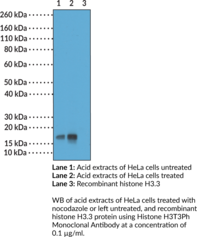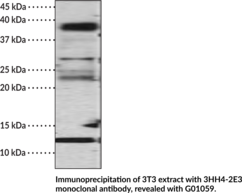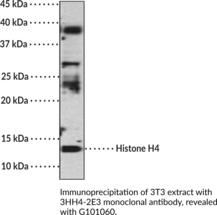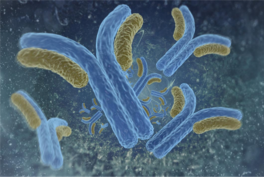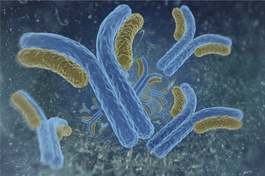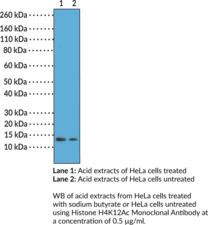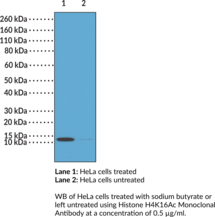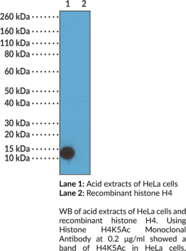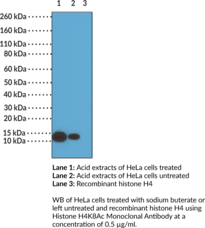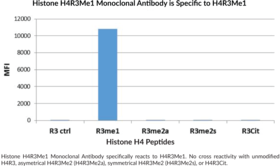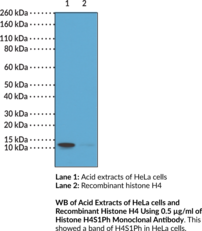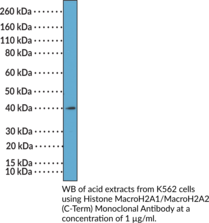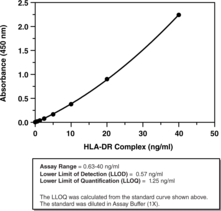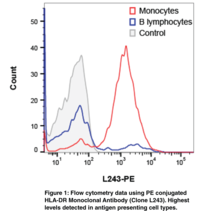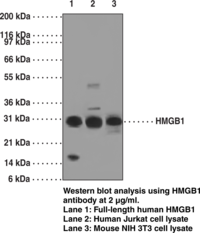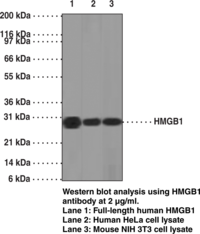Cayman
Showing 24001–24150 of 45550 results
-
Histone H3 is a nuclear protein and a component of the nucleosome core, a basic unit of chromatin, that is essential for organizing genomic DNA in eukaryotic nuclei.{57056} It is a globular protein that contains an unstructured N-terminal tail that extends outside of the nucleosome core and is subject to various post-translational modifications (PTMs), including methylation, phosphorylation, acetylation, and citrullination.{57056,53978} Phosphorylation of histone H3 at threonine 3 (H3T3Ph), catalyzed by the serine/threonine protein kinase haspin, is involved in the localization of the chromosomal passenger complex (CPC) at centromeres during mitosis and chromatin condensation during meiosis.{57288,57289} Cayman’s Histone H3T3Ph Monoclonal Antibody can be used for ELISA, immunocytochemistry (ICC), immunohistochemistry (IHC), multiplex-based assay, and Western blot (WB) applications.
Brand:CaymanSKU:32165 - 100 µgAvailable on backorder
Brand:CaymanSKU:32958- 100 µlHistone H4 is a structural component of the nucleosome and is subject to covalent modification including acetylation and methylation, which may alter expression of genes located on DNA associated with its parent histone octamer. The Histone H4 clone 3HH-4C10 monoclonal recognize H4 when actelylated at list on of the for Lysine 12 whatever the status of K5, K8 and K16. [Bertin Catalog No. G01059]
Brand:CaymanSKU:32958 - 100 µlAvailable on backorder
Brand:CaymanSKU:32958- 100 µlAvailable on backorder
Brand:CaymanSKU:32959- 100 µlHistone H4 is a structural component of the nucleosome and is subject to covalent modification including acetylation and methylation, which may alter expression of genes located on DNA associated with its parent histone octamer. The Histone H4 clone 3HH-3E7 monoclonal recognize H4 when actelylated on at list on of the for Lysine 5 or 12, whatever the status of K8 and K16. [Bertin Catalog No. G01060]
Brand:CaymanSKU:32959 - 100 µlAvailable on backorder
Brand:CaymanSKU:32959- 100 µlAvailable on backorder
Brand:CaymanSKU:32943- 100 µlHistone H4 is a structural component of the nucleosome and is subject to covalent modification including acetylation and methylation, which may alter expression of genes located on DNA associated with its parent histone octamer. The Histone H4 clone 3HH-2C2 monoclonal recognize H4 when actelylated on at list on of the for Lysine residues K5, K8, K12 or K16. [Bertin Catalog No. G01058]
Brand:CaymanSKU:32943 - 100 µlAvailable on backorder
Brand:CaymanSKU:32943- 100 µlAvailable on backorder
Histone H4 is a structural component of the nucleosome and is subject to covalent modification including acetylation and methylation, which may alter expression of genes located on DNA associated with its parent histone octamer. [Bertin Catalog No. G01057]
Brand:CaymanSKU:32942 - 100 µlAvailable on backorder
Brand:CaymanSKU:32942- 100 µlAvailable on backorder
Brand:CaymanSKU:32942- 100 µlAntigen: synthetic peptide corresponding to human histone H4 amino acids 15-30 • Host: rabbit • Cross-Reactivity: (+) Human histone H4 • Application(s): WB • Histone H4 is a structural component of the nucleosome and is subject to covalent modification including acetylation and methylation, which may alter expression of genes located on DNA associated with its parent histone octamer.
Brand:CaymanSKU:13543- 1 eaAvailable on backorder
Antigen: synthetic peptide corresponding to human histone H4 amino acids 15-30 • Host: rabbit • Cross-Reactivity: (+) Human histone H4 • Application(s): WB • Histone H4 is a structural component of the nucleosome and is subject to covalent modification including acetylation and methylation, which may alter expression of genes located on DNA associated with its parent histone octamer.
Brand:CaymanSKU:13543- 1 eaHistones are relatively small proteins that contain a high proportion of positively charged amino acids, e.g., arginine and lysine. This positive charge allows histones to bind tightly to the negatively charged DNA. There are five basic types of histone molecules called H1, H2A, H2B, H3, and H4. Histones are abundantly present in virtually all eukaryotic cells.
Brand:CaymanSKU:13543 - 1 eaAvailable on backorder
Immunogen: Peptide corresponding to H4K12Ac • Host: Rabbit • Species Reactivity: (+) Vertebrates • Cross Reactivity: (+) H4K12Ac; (-) Unmodified H4K12, H4K5Ac, H4K8Ac, H4K16Ac, H4K20Ac, H4K31Ac, H4K91Ac • Applications: ChIP, ELISA, ICC, multiplex-based assays, WB
Brand:CaymanSKU:32162- 100 µgAvailable on backorder
Immunogen: Peptide corresponding to H4K12Ac • Host: Rabbit • Species Reactivity: (+) Vertebrates • Cross Reactivity: (+) H4K12Ac; (-) Unmodified H4K12, H4K5Ac, H4K8Ac, H4K16Ac, H4K20Ac, H4K31Ac, H4K91Ac • Applications: ChIP, ELISA, ICC, multiplex-based assays, WB
Brand:CaymanSKU:32162- 100 µgHistone H4 is one of four core histone proteins that are involved in the organization of DNA into chromatin.{18136} Histones are globular proteins with unstructured N-terminal tails and are subject to a variety of post-translational modifications, such as methylation, acetylation, phosphorylation, and citrullination, that can influence chromatin structure and regulate gene transcription.{18136,57056} Acetylation of histone H4 at lysine 12 (H4K12Ac) is associated with chromatin relaxation and gene transcription.{57287} Levels of H4K12Ac are elevated in two transgenic mouse models of Alzheimer’s disease, as well as in monocytes isolated from patients with mild cognitive impairment and Alzheimer’s disease. H4K12Ac levels are also increased in response to chronic alcohol exposure and positively correlate with the release of the pro-inflammatory cytokine chemokine (C-C motif) ligand 8 (CCL8) in monocyte-derived dendritic cells.{57210} Cayman’s H4K12Ac Monoclonal Antibody can be used for chromatin immunoprecipitation (ChIP), ELISA, immunocytochemistry (ICC), multiplex-based assay, and Western blot (WB) applications.
Brand:CaymanSKU:32162 - 100 µgAvailable on backorder
Immunogen: Peptide corresponding to H4K16Ac • Host: Rabbit • Species Reactivity: (+) Vertebrates • Cross Reactivity: (+) H4K16Ac; (-) Unmodified H4K16, H4K5Ac, H4K8Ac, H4K12Ac, H4K20Ac, H4K31Ac, H4K91Ac • Applications: ELISA, multiplex-based assay, WB
Brand:CaymanSKU:32158- 100 µgAvailable on backorder
Immunogen: Peptide corresponding to H4K16Ac • Host: Rabbit • Species Reactivity: (+) Vertebrates • Cross Reactivity: (+) H4K16Ac; (-) Unmodified H4K16, H4K5Ac, H4K8Ac, H4K12Ac, H4K20Ac, H4K31Ac, H4K91Ac • Applications: ELISA, multiplex-based assay, WB
Brand:CaymanSKU:32158- 100 µgHistone H4 is one of four core histone proteins that are involved in the organization of DNA into chromatin.{18136} Histones are globular proteins with unstructured N-terminal tails and are subject to a variety of post-translational modifications, such as methylation, acetylation, phosphorylation, and citrullination, that can influence chromatin structure and regulate gene transcription.{18136,57056} Acetylation of histone H4 at lysine 16 (H4K16Ac) is associated with transcriptional activation.{42735} Cellular H4K16Ac levels are decreased in Jurkat and HL-60 leukemia cells compared with normal human lymphocytes, and tumor H4K16Ac levels are reduced in patients with lymphoma or colorectal cancer.{59476} Cayman’s Histone H4K16Ac Monoclonal Antibody can be used for ELISA, multiplex-based assay, and Western blot (WB) applications.
Brand:CaymanSKU:32158 - 100 µgAvailable on backorder
Immunogen: Peptide corresponding to H4K5Ac • Host: Rabbit • Species Reactivity: (+) Vertebrates • Cross Reactivity: (+) H4K5Ac; (-) Unmodified H4K5, H4K8Ac, H4K12Ac, H4K16Ac, H4K20Ac, H4K31Ac, H4K91Ac • Applications: ELISA, ICC, multiplex-based assay, WB
Brand:CaymanSKU:32156- 100 µgAvailable on backorder
Immunogen: Peptide corresponding to H4K5Ac • Host: Rabbit • Species Reactivity: (+) Vertebrates • Cross Reactivity: (+) H4K5Ac; (-) Unmodified H4K5, H4K8Ac, H4K12Ac, H4K16Ac, H4K20Ac, H4K31Ac, H4K91Ac • Applications: ELISA, ICC, multiplex-based assay, WB
Brand:CaymanSKU:32156- 100 µgHistone H4 is one of four core histone proteins that are involved in the organization of DNA into chromatin.{18136} Histones are globular proteins with unstructured N-terminal tails and are subject to a variety of posttranslational modifications, such as methylation, acetylation, phosphorylation, and citrullination, that can influence chromatin structure and regulate gene transcription.{18136,57056} Acetylation of histone H4 at lysine 5 (H4K5Ac) is enriched in promoter regions and coding sequences in mouse hippocampus and is associated with active chromatin.{57203,57204} Hippocampal levels of H4K5Ac increase following contextual fear conditioning in mice.{57203} Levels of H4K5Ac are elevated in postmortem brain tissue isolated from fetuses with spina bifida compared with healthy controls.{57205} Global levels of H4K5Ac are decreased in blast cells from patients with acute myeloid leukemia compared with healthy individuals, and low levels of H4K5Ac are associated with poor prognosis in these patients.{57206} Cayman’s Histone H4K5Ac Monoclonal Antibody can be used for ELISA, immunocytochemistry (ICC), multiplex-based assay, and Western blot (WB) applications.
Brand:CaymanSKU:32156 - 100 µgAvailable on backorder
Immunogen: Peptide corresponding to H4K8Ac • Host: Rabbit • Species Reactivity: (+) Vertebrates • Cross Reactivity: (+) H4K8Ac; (-) Unmodified H4K8, H4K5Ac, H4K12Ac, H4K16Ac, H4K20Ac, H4K31Ac, H4K91Ac • Applications: ChIP, ELISA, ICC, multiplex-based assays, WB
Brand:CaymanSKU:32157- 100 µgAvailable on backorder
Immunogen: Peptide corresponding to H4K8Ac • Host: Rabbit • Species Reactivity: (+) Vertebrates • Cross Reactivity: (+) H4K8Ac; (-) Unmodified H4K8, H4K5Ac, H4K12Ac, H4K16Ac, H4K20Ac, H4K31Ac, H4K91Ac • Applications: ChIP, ELISA, ICC, multiplex-based assays, WB
Brand:CaymanSKU:32157- 100 µgHistone H4 is one of four core histone proteins that are involved in the organization of DNA into chromatin.{18136} Histones are globular proteins with unstructured N-terminal tails and are subject to a variety of post-translational modifications, such as methylation, acetylation, phosphorylation, and citrullination, that can influence chromatin structure and regulate gene transcription.{18136,57056} Acetylation of histone H4 at lysine 8 (H4K8Ac) is associated with transcriptional activation and mediates recruitment of SWI/SNF chromatin remodeling complexes.{42735,47280} P. falciparum schizonts expressing a lysine-to-arginine substitution at Lys8 in histone 4, which prevents its acetylation, have increased multiplication rates.{58040} Tumor H4K8Ac levels are increased in patients with breast cancer.{54329} Cayman’s Histone H4K8Ac Monoclonal Antibody can be used for chromatin immunoprecipitation (ChIP), ELISA, immunocytochemistry (ICC), multiplex-based assay, and Western blot (WB) applications.
Brand:CaymanSKU:32157 - 100 µgAvailable on backorder
Immunogen: Peptide corresponding to H4R3Me1 • Host: Rabbit • Species Reactivity: (+) Vertebrates • Cross Reactivity: (+) H4R3Me1; (-) Unmodified H4R3, H4R3Me2a, H4R3Me2s, H4R3Cit • Applications: ELISA, ICC, multiplex-based assays, WB
Brand:CaymanSKU:32155- 100 µgAvailable on backorder
Immunogen: Peptide corresponding to H4R3Me1 • Host: Rabbit • Species Reactivity: (+) Vertebrates • Cross Reactivity: (+) H4R3Me1; (-) Unmodified H4R3, H4R3Me2a, H4R3Me2s, H4R3Cit • Applications: ELISA, ICC, multiplex-based assays, WB
Brand:CaymanSKU:32155- 100 µgHistone H4 is one of four core histone proteins that are involved in the organization of DNA into chromatin.{18136} Histones are globular proteins with unstructured N-terminal tails and are subject to a variety of post-translational modifications, such as methylation, acetylation, phosphorylation, and citrullination, that can influence chromatin structure and regulate gene transcription.{18136,57056} Histone H4 can be monomethylated at arginine 3 (H4R3Me1) by protein arginine methyltransferase 1 (PRMT1), PRMT5, and PRMT6.{60024} Retinal levels of H4R3Me1 are reduced in a rat model of diabetes induced by streptozotocin (STZ; Item No. 13104) compared with non-diabetic controls.{60021} Cayman’s Histone H4R3Me1 Monoclonal Antibody can be used for ELISA, immunocytochemistry (ICC), multiplex-based assay, and Western blot (WB) applications.
Brand:CaymanSKU:32155 - 100 µgAvailable on backorder
Immunogen: Peptide corresponding to H4S1Ph • Host: Rabbit • Species Reactivity: (+) Vertebrates • Cross Reactivity: (+) H4S1Ph, H4S1Ph/R3Me1, H4S1Ph/R3Me2; (-) Unmodified histone H4, H2AS1Ph • Applications: ELISA, ICC, multiplex-based assays, WB
Brand:CaymanSKU:32154- 100 µgAvailable on backorder
Immunogen: Peptide corresponding to H4S1Ph • Host: Rabbit • Species Reactivity: (+) Vertebrates • Cross Reactivity: (+) H4S1Ph, H4S1Ph/R3Me1, H4S1Ph/R3Me2; (-) Unmodified histone H4, H2AS1Ph • Applications: ELISA, ICC, multiplex-based assays, WB
Brand:CaymanSKU:32154- 100 µgHistone H4 is one of four core histone proteins that are involved in the organization of DNA into chromatin.{18136} Histones are globular proteins with unstructured N-terminal tails and are subject to a variety of post-translational modifications, such as methylation, acetylation, phosphorylation, and citrullination, that can influence chromatin structure and regulate gene transcription.{18136,57056} Phosphorylation of histone H4 at serine 1 (H4S1Ph) is increased during the S-phase and mitosis in HeLa cells, C. elegans, and Drosophila, as well as during spermatogenesis in mice.{54369,54370} MG-63 cells expressing a serine-to-alanine substitution at Ser1 in histone H4, which abolishes its phosphorylation, have reduced markers of autophagy. Cayman’s Histone H4S1Ph Monoclonal Antibody can be used for ELISA, immunocytochemistry (ICC), multiplex-based assays, and Western blot (WB) applications.
Brand:CaymanSKU:32154 - 100 µgAvailable on backorder
Immunogen: Peptide corresponding to the C-terminus of human macroH2A1 • Host: Rabbit • Species Reactivity: (+) Vertebrates • Cross Reactivity: (+) MacroH2A1 and macroH2A2 independent of PTMs; (-) Other histones • Applications: ELISA, ICC, multiplex-based assays, WB
Brand:CaymanSKU:32176- 100 µgAvailable on backorder
Immunogen: Peptide corresponding to the C-terminus of human macroH2A1 • Host: Rabbit • Species Reactivity: (+) Vertebrates • Cross Reactivity: (+) MacroH2A1 and macroH2A2 independent of PTMs; (-) Other histones • Applications: ELISA, ICC, multiplex-based assays, WB
Brand:CaymanSKU:32176- 100 µgMacroH2A proteins are variant histones that are enriched on inactivated X chromosomes and have roles in the maintenance of nuclear organization and heterochromatin architecture.{57292,57293,58069} MacroH2A1 is encoded by MACROH2A1 and can exist as two isoforms, macroH2A1.1 and macroH2A1.2, produced by alternative splicing, and macroH2A2 is encoded by MACROH2A2.{57293} MacroH2As are comprised of a histone fold, which is approximately 65% identical to canonical histone H2A, a basic linker, and a C-terminal non-histone macrodomain, which is unique to macroH2As and protrudes from the nucleosome core to recruit various co-factors.{58069,57292,57293} The non-histone region of macroH2A2 is 68% identical to that of macroH2A1.2, whereas the macrodomain of macroH2A1.1 is unique in that it can bind to ADP-ribose and ADP-ribosylated proteins.{57293,58069} Low levels of macroH2A1.1 are associated with poor prognosis in patients with lung or colon cancer, and loss of macroH2A2 expression is associated with earlier recurrence of lesions in patients with anal intraepithelial neoplasia (AIN).{58069,57294} MacroH2A1.2 expression is increased in highly proliferative cancer cell lines, but it can act as a tumor suppressor in melanoma and bladder cancer, indicating that its role in cancer is context-dependent. Cayman’s Histone MacroH2A1/MacroH2A2 (C-Term) Monoclonal Antibody can be used for ELISA, immunocytochemistry (ICC), multiplex-based assay, and Western blot (WB) applications. The antibody recognizes the C-terminus of macroH2A1 and macroH2A2 independent of post-translational modifications (PTMs).
Brand:CaymanSKU:32176 - 100 µgAvailable on backorder
Histrelin is a synthetic gonadotropin-releasing hormone (GNRH) agonist that binds to the GNRH receptor (GNRHR; Ki = 0.2 nM in CHO cells expressing the human receptor).{36464} It stimulates release of oxytocin (Item No. 11799) and vasopressin ex vivo from the isolated rat hypothalamo-neurohypophysial system at a concentration of 100 nM.{36469,36470} In vivo, the initial dose of histrelin (100 μg) stimulates acute increases in luteinizing hormone (LH), follicle-stimulating hormone (FSH), and testosterone serum levels (50-, 2.5-, and 15-fold, respectively), while chronic treatment leads to 95% decreases in LH and FSH responses in rhesus monkeys.{36471} Formulations containing histrelin have been used in the treatment of advanced prostate cancer and central precocious puberty.
Brand:CaymanSKU:23663 - 1 mgAvailable on backorder
Histrelin is a synthetic gonadotropin-releasing hormone (GNRH) agonist that binds to the GNRH receptor (GNRHR; Ki = 0.2 nM in CHO cells expressing the human receptor).{36464} It stimulates release of oxytocin (Item No. 11799) and vasopressin ex vivo from the isolated rat hypothalamo-neurohypophysial system at a concentration of 100 nM.{36469,36470} In vivo, the initial dose of histrelin (100 μg) stimulates acute increases in luteinizing hormone (LH), follicle-stimulating hormone (FSH), and testosterone serum levels (50-, 2.5-, and 15-fold, respectively), while chronic treatment leads to 95% decreases in LH and FSH responses in rhesus monkeys.{36471} Formulations containing histrelin have been used in the treatment of advanced prostate cancer and central precocious puberty.
Brand:CaymanSKU:23663 - 10 mgAvailable on backorder
Histrelin is a synthetic gonadotropin-releasing hormone (GNRH) agonist that binds to the GNRH receptor (GNRHR; Ki = 0.2 nM in CHO cells expressing the human receptor).{36464} It stimulates release of oxytocin (Item No. 11799) and vasopressin ex vivo from the isolated rat hypothalamo-neurohypophysial system at a concentration of 100 nM.{36469,36470} In vivo, the initial dose of histrelin (100 μg) stimulates acute increases in luteinizing hormone (LH), follicle-stimulating hormone (FSH), and testosterone serum levels (50-, 2.5-, and 15-fold, respectively), while chronic treatment leads to 95% decreases in LH and FSH responses in rhesus monkeys.{36471} Formulations containing histrelin have been used in the treatment of advanced prostate cancer and central precocious puberty.
Brand:CaymanSKU:23663 - 5 mgAvailable on backorder
HJC0152 is an orally bioavailable inhibitor of STAT3 (32 and 62% inhibition at 10 and 20 µM, respectively, in MDA-MB-231 cells in a luciferase reporter assay).{38366} It reduces total STAT3 and phosphorylated STAT3 levels in MDA-MB-231 cells and inhibits nuclear translocation of phosphorylated STAT3. HJC0152 inhibits proliferation of MCF-7 and MDA-MB-231 breast cancer and AsPC-1 and PANC-1 pancreatic cancer cells (IC50s = 0.91, 1.64, 1.9, and 1.08 µM, respectively). It also halts the cell cycle at the G0/G1 phase, induces apoptosis, and suppresses cell proliferation in human head and neck squamous cell carcinoma cells.{38367} HJC0152 (7.5 mg/kg, i.p. or 25 mg/kg, p.o.) inhibits tumor growth in an MDA-MB-231 breast cancer mouse xenograft model and in an orthotopic mouse model of squamous cell carcinoma.{38366,38367}
Brand:CaymanSKU:22351 -Out of stock
HJC0152 is an orally bioavailable inhibitor of STAT3 (32 and 62% inhibition at 10 and 20 µM, respectively, in MDA-MB-231 cells in a luciferase reporter assay).{38366} It reduces total STAT3 and phosphorylated STAT3 levels in MDA-MB-231 cells and inhibits nuclear translocation of phosphorylated STAT3. HJC0152 inhibits proliferation of MCF-7 and MDA-MB-231 breast cancer and AsPC-1 and PANC-1 pancreatic cancer cells (IC50s = 0.91, 1.64, 1.9, and 1.08 µM, respectively). It also halts the cell cycle at the G0/G1 phase, induces apoptosis, and suppresses cell proliferation in human head and neck squamous cell carcinoma cells.{38367} HJC0152 (7.5 mg/kg, i.p. or 25 mg/kg, p.o.) inhibits tumor growth in an MDA-MB-231 breast cancer mouse xenograft model and in an orthotopic mouse model of squamous cell carcinoma.{38366,38367}
Brand:CaymanSKU:22351 -Out of stock
HJC0152 is an orally bioavailable inhibitor of STAT3 (32 and 62% inhibition at 10 and 20 µM, respectively, in MDA-MB-231 cells in a luciferase reporter assay).{38366} It reduces total STAT3 and phosphorylated STAT3 levels in MDA-MB-231 cells and inhibits nuclear translocation of phosphorylated STAT3. HJC0152 inhibits proliferation of MCF-7 and MDA-MB-231 breast cancer and AsPC-1 and PANC-1 pancreatic cancer cells (IC50s = 0.91, 1.64, 1.9, and 1.08 µM, respectively). It also halts the cell cycle at the G0/G1 phase, induces apoptosis, and suppresses cell proliferation in human head and neck squamous cell carcinoma cells.{38367} HJC0152 (7.5 mg/kg, i.p. or 25 mg/kg, p.o.) inhibits tumor growth in an MDA-MB-231 breast cancer mouse xenograft model and in an orthotopic mouse model of squamous cell carcinoma.{38366,38367}
Brand:CaymanSKU:22351 -Out of stock
Exchange protein activated by cAMP (Epac) proteins mediate cAMP signaling independent of protein kinase A (PKA). HJC0197 is a cell-permeable inhibitor of Epac1 and Epac2 (IC50 = 5.9 µM for Epac2).{30769} It inhibits Epac1-mediated Rap1-GDP exchange activity at 25 µM, but has no effect on cAMP-induced type I and II PKA activity at this concentration.{30769} Pretreatment of HEK293 cells expressing either Epac1 or Epac2 with 10 µM HJC0197 completely blocks Epac-mediated phosphorylation of Akt.{30769} HJC0197 has been used to study the role of Epac signaling in chondrogenesis in chicken micromass cultures.{30770}
Brand:CaymanSKU:-Available on backorder
Exchange protein activated by cAMP (Epac) proteins mediate cAMP signaling independent of protein kinase A (PKA). HJC0197 is a cell-permeable inhibitor of Epac1 and Epac2 (IC50 = 5.9 µM for Epac2).{30769} It inhibits Epac1-mediated Rap1-GDP exchange activity at 25 µM, but has no effect on cAMP-induced type I and II PKA activity at this concentration.{30769} Pretreatment of HEK293 cells expressing either Epac1 or Epac2 with 10 µM HJC0197 completely blocks Epac-mediated phosphorylation of Akt.{30769} HJC0197 has been used to study the role of Epac signaling in chondrogenesis in chicken micromass cultures.{30770}
Brand:CaymanSKU:-Available on backorder
Exchange protein activated by cAMP (Epac) proteins mediate cAMP signaling independent of protein kinase A (PKA). HJC0197 is a cell-permeable inhibitor of Epac1 and Epac2 (IC50 = 5.9 µM for Epac2).{30769} It inhibits Epac1-mediated Rap1-GDP exchange activity at 25 µM, but has no effect on cAMP-induced type I and II PKA activity at this concentration.{30769} Pretreatment of HEK293 cells expressing either Epac1 or Epac2 with 10 µM HJC0197 completely blocks Epac-mediated phosphorylation of Akt.{30769} HJC0197 has been used to study the role of Epac signaling in chondrogenesis in chicken micromass cultures.{30770}
Brand:CaymanSKU:-Available on backorder
HJC0350 is a selective inhibitor of exchange protein directly activated by cAMP 2 (Epac2) with an IC50 value of 300 nM for competition with 8-NBD-cAMP binding.{39180} It inhibits Epac2 guanine nucleotide exchange activity but does not inhibit Epac1-mediated Rap1-GDP exchange or cAMP-mediated protein kinase A (PKA) activation in vitro, indicating it is selective for Epac2 at a concentration of 25 μM. HJC0350 also blocks stimulation of Epac2, but not Epac1, by 007-AM in HEK293 cells.
Brand:CaymanSKU:22949 - 1 mgAvailable on backorder
HJC0350 is a selective inhibitor of exchange protein directly activated by cAMP 2 (Epac2) with an IC50 value of 300 nM for competition with 8-NBD-cAMP binding.{39180} It inhibits Epac2 guanine nucleotide exchange activity but does not inhibit Epac1-mediated Rap1-GDP exchange or cAMP-mediated protein kinase A (PKA) activation in vitro, indicating it is selective for Epac2 at a concentration of 25 μM. HJC0350 also blocks stimulation of Epac2, but not Epac1, by 007-AM in HEK293 cells.
Brand:CaymanSKU:22949 - 10 mgAvailable on backorder
HJC0350 is a selective inhibitor of exchange protein directly activated by cAMP 2 (Epac2) with an IC50 value of 300 nM for competition with 8-NBD-cAMP binding.{39180} It inhibits Epac2 guanine nucleotide exchange activity but does not inhibit Epac1-mediated Rap1-GDP exchange or cAMP-mediated protein kinase A (PKA) activation in vitro, indicating it is selective for Epac2 at a concentration of 25 μM. HJC0350 also blocks stimulation of Epac2, but not Epac1, by 007-AM in HEK293 cells.
Brand:CaymanSKU:22949 - 25 mgAvailable on backorder
HJC0350 is a selective inhibitor of exchange protein directly activated by cAMP 2 (Epac2) with an IC50 value of 300 nM for competition with 8-NBD-cAMP binding.{39180} It inhibits Epac2 guanine nucleotide exchange activity but does not inhibit Epac1-mediated Rap1-GDP exchange or cAMP-mediated protein kinase A (PKA) activation in vitro, indicating it is selective for Epac2 at a concentration of 25 μM. HJC0350 also blocks stimulation of Epac2, but not Epac1, by 007-AM in HEK293 cells.
Brand:CaymanSKU:22949 - 5 mgAvailable on backorder
HKI 357 is an irreversible dual inhibitor of the EGF receptor tyrosine kinases EGFR and HER2 (IC50s = 34 and 33 nM, respectively).{39458} It inhibits proliferation of A431, SK-BR-3, and SW620 cancer cell lines (IC50s = 120, 2.5, and 511 nM, respectively). HKI 357 suppresses EGFR autophosphorylation and phosphorylation of the downstream effectors AKT and ERK in the gefitinib-susceptible and -resistant cell lines NCI-H1650 and NCI-H1650(G7), respectively.{30795} In vivo, HKI 357 (10 mg/kg) inhibits tumor growth in BT474, A431, and SUM190 mouse xenograft models.{39458}
Brand:CaymanSKU:-HKI 357 is an irreversible dual inhibitor of the EGF receptor tyrosine kinases EGFR and HER2 (IC50s = 34 and 33 nM, respectively).{39458} It inhibits proliferation of A431, SK-BR-3, and SW620 cancer cell lines (IC50s = 120, 2.5, and 511 nM, respectively). HKI 357 suppresses EGFR autophosphorylation and phosphorylation of the downstream effectors AKT and ERK in the gefitinib-susceptible and -resistant cell lines NCI-H1650 and NCI-H1650(G7), respectively.{30795} In vivo, HKI 357 (10 mg/kg) inhibits tumor growth in BT474, A431, and SUM190 mouse xenograft models.{39458}
Brand:CaymanSKU:-HKI 357 is an irreversible dual inhibitor of the EGF receptor tyrosine kinases EGFR and HER2 (IC50s = 34 and 33 nM, respectively).{39458} It inhibits proliferation of A431, SK-BR-3, and SW620 cancer cell lines (IC50s = 120, 2.5, and 511 nM, respectively). HKI 357 suppresses EGFR autophosphorylation and phosphorylation of the downstream effectors AKT and ERK in the gefitinib-susceptible and -resistant cell lines NCI-H1650 and NCI-H1650(G7), respectively.{30795} In vivo, HKI 357 (10 mg/kg) inhibits tumor growth in BT474, A431, and SUM190 mouse xenograft models.{39458}
Brand:CaymanSKU:-Cayman’s HLA-DR (α and β chains) ELISA Kit is an immunometric assay (i.e., sandwich) that can be used for the quantification of the HLA-DR complex in cell lysates. The standard curve spans the range of 0.63-40 ng/ml, with a limit of quantification of 1.25 ng/ml.
Brand:CaymanSKU:501810 - 96 wellsAvailable on backorder
HLA-DR (α and β chains) ELISA Standard has been tested and formulated to work exclusively with Cayman’s HLA-DR (α and β chains) ELISA Kit (Item No. 501810). Please visit HLA-DR (α and β chains) ELISA Kit (Item No. 501810) for the kit protocol, procedures, and product handling.
Brand:CaymanSKU:480131 - 200 ngAvailable on backorder
Immunogen: Human lymphoblastoid cell line (RPMI 8866) • Clone designation: L243 • Host: Mouse • Species Reactivity: (+) Human, canine, and non-human primate HLA-DR • Isotype: IgG2a • Applications: FC, ICC, IF, IHC, IP, and WB
Brand:CaymanSKU:21827- 100 µgAvailable on backorder
Immunogen: Human lymphoblastoid cell line (RPMI 8866) • Clone designation: L243 • Host: Mouse • Species Reactivity: (+) Human, canine, and non-human primate HLA-DR • Isotype: IgG2a • Applications: FC, ICC, IF, IHC, IP, and WB
Brand:CaymanSKU:21827- 100 µgHLA-DR is a MHC Class II cell surface receptor heterodimer composed of a 33-35 kDa α chain, a ~30 kDa β chain, and a 10-30 amino acid ligand.{33426} When the heterodimer is fully combined on the cell surface of an antigen-presenting cell, such as macrophages, B cells, and dendritic cells, they present that ligand primarily to CD-4+ T cells.{15687} This presentation coupled with the T cell response can stimulate or suppress an antibody response to that ligand.{15687} HLR-DRs have been linked to a number of autoimmune disorders such as rheumatoid arthritis, lupus, and psoriasis as well as diabetes, hepatitis, and sclerosis among a number of others.{34485,34486,34487,34488,34489,34490,34491} Cayman’s HLA-DR Monoclonal Antibody (Clone L243) detects HLA-DR with or without attached ligand. The predicated size of the HLA-DRα or HLA-DRβ subunits is ~29-30 kDa.
Brand:CaymanSKU:21827 - 100 µgAvailable on backorder
HLCL-61 is an inhibitor of protein arginine methyltransferase 5 (PRMT5) that inhibits the growth of multiple acute myeloid leukemia (AML) cell lines and patient-derived tumor samples (IC50s = 7.21-21.46 and 3.98-8.72 μM, respectively).{38426} It is selective for PRMT5, lacking activity against PRMT1, PRMT4, and PRMT7 in an enzyme assay. HLCL-61 induces myeloid differentiation of THP-1 cells and increases CD11b expression in a dose-dependent manner. It also increases expression of miR-29b mRNA resulting in a 4-fold decrease in FLT3 activity in THP-1 cells expressing an FLT3 luciferase reporter.
Brand:CaymanSKU:19897 -Available on backorder
HLCL-61 is an inhibitor of protein arginine methyltransferase 5 (PRMT5) that inhibits the growth of multiple acute myeloid leukemia (AML) cell lines and patient-derived tumor samples (IC50s = 7.21-21.46 and 3.98-8.72 μM, respectively).{38426} It is selective for PRMT5, lacking activity against PRMT1, PRMT4, and PRMT7 in an enzyme assay. HLCL-61 induces myeloid differentiation of THP-1 cells and increases CD11b expression in a dose-dependent manner. It also increases expression of miR-29b mRNA resulting in a 4-fold decrease in FLT3 activity in THP-1 cells expressing an FLT3 luciferase reporter.
Brand:CaymanSKU:19897 -Available on backorder
HLCL-61 is an inhibitor of protein arginine methyltransferase 5 (PRMT5) that inhibits the growth of multiple acute myeloid leukemia (AML) cell lines and patient-derived tumor samples (IC50s = 7.21-21.46 and 3.98-8.72 μM, respectively).{38426} It is selective for PRMT5, lacking activity against PRMT1, PRMT4, and PRMT7 in an enzyme assay. HLCL-61 induces myeloid differentiation of THP-1 cells and increases CD11b expression in a dose-dependent manner. It also increases expression of miR-29b mRNA resulting in a 4-fold decrease in FLT3 activity in THP-1 cells expressing an FLT3 luciferase reporter.
Brand:CaymanSKU:19897 -Available on backorder
HLCL-61 is an inhibitor of protein arginine methyltransferase 5 (PRMT5) that inhibits the growth of multiple acute myeloid leukemia (AML) cell lines and patient-derived tumor samples (IC50s = 7.21-21.46 and 3.98-8.72 μM, respectively).{38426} It is selective for PRMT5, lacking activity against PRMT1, PRMT4, and PRMT7 in an enzyme assay. HLCL-61 induces myeloid differentiation of THP-1 cells and increases CD11b expression in a dose-dependent manner. It also increases expression of miR-29b mRNA resulting in a 4-fold decrease in FLT3 activity in THP-1 cells expressing an FLT3 luciferase reporter.
Brand:CaymanSKU:19897 -Available on backorder
HLM006474 is a non-selective inhibitor of the transcription factor E2F (IC50 = 29.8 µM for E2F4).{45457} It inhibits DNA binding to E2F1, E2F2, and E2F4 in A375 melanoma cells when used at a concentration of 40 µM. HLM006474 (40 µM) decreases protein levels of E2F4 and cyclin D3 and induces apoptosis in A375 cells. It also induces apoptosis in MDA-MB-231, but not MCF-7, cells and inhibits the growth of cancer cells in a panel of 17 lung cancer cell lines (IC50s = 15.5-75.1 µM).{45457,45458} HLM006474 reduces tumor growth in retinoblastoma-prone Chx10Cre;Rbfl/fl;p107-/- mice and in an A375 mouse xenograft model when administered at a dose of 100 mg/kg and 2 mg per mouse, respectively.{45459,45460}
Brand:CaymanSKU:28276 - 10 mgAvailable on backorder
HLM006474 is a non-selective inhibitor of the transcription factor E2F (IC50 = 29.8 µM for E2F4).{45457} It inhibits DNA binding to E2F1, E2F2, and E2F4 in A375 melanoma cells when used at a concentration of 40 µM. HLM006474 (40 µM) decreases protein levels of E2F4 and cyclin D3 and induces apoptosis in A375 cells. It also induces apoptosis in MDA-MB-231, but not MCF-7, cells and inhibits the growth of cancer cells in a panel of 17 lung cancer cell lines (IC50s = 15.5-75.1 µM).{45457,45458} HLM006474 reduces tumor growth in retinoblastoma-prone Chx10Cre;Rbfl/fl;p107-/- mice and in an A375 mouse xenograft model when administered at a dose of 100 mg/kg and 2 mg per mouse, respectively.{45459,45460}
Brand:CaymanSKU:28276 - 25 mgAvailable on backorder
HLM006474 is a non-selective inhibitor of the transcription factor E2F (IC50 = 29.8 µM for E2F4).{45457} It inhibits DNA binding to E2F1, E2F2, and E2F4 in A375 melanoma cells when used at a concentration of 40 µM. HLM006474 (40 µM) decreases protein levels of E2F4 and cyclin D3 and induces apoptosis in A375 cells. It also induces apoptosis in MDA-MB-231, but not MCF-7, cells and inhibits the growth of cancer cells in a panel of 17 lung cancer cell lines (IC50s = 15.5-75.1 µM).{45457,45458} HLM006474 reduces tumor growth in retinoblastoma-prone Chx10Cre;Rbfl/fl;p107-/- mice and in an A375 mouse xenograft model when administered at a dose of 100 mg/kg and 2 mg per mouse, respectively.{45459,45460}
Brand:CaymanSKU:28276 - 5 mgAvailable on backorder
Wnt signaling proteins are small secreted proteins that are active in embryonic development, tissue homeostasis, and tumorigenesis.{14336,13185,17947} HLY78 is a positive modulator of the Wnt/β-catenin pathway, as it augments Wnt-mediated signaling in cells at concentrations of 5 to 20 µM.{30791} It has no significant effect alone, and it does not affect LiCl-stimulated β-catenin signaling. A biotinylated form of HLY78 binds Axin at its DIX domain, which is thought to potentiate Axin-LRP6 association.{30791} HLY78 activates Wnt signaling in vivo, altering Wnt-dependent gene expression and embryonic development in zebrafish.{30791}
Brand:CaymanSKU:-Available on backorder
Wnt signaling proteins are small secreted proteins that are active in embryonic development, tissue homeostasis, and tumorigenesis.{14336,13185,17947} HLY78 is a positive modulator of the Wnt/β-catenin pathway, as it augments Wnt-mediated signaling in cells at concentrations of 5 to 20 µM.{30791} It has no significant effect alone, and it does not affect LiCl-stimulated β-catenin signaling. A biotinylated form of HLY78 binds Axin at its DIX domain, which is thought to potentiate Axin-LRP6 association.{30791} HLY78 activates Wnt signaling in vivo, altering Wnt-dependent gene expression and embryonic development in zebrafish.{30791}
Brand:CaymanSKU:-Available on backorder
Wnt signaling proteins are small secreted proteins that are active in embryonic development, tissue homeostasis, and tumorigenesis.{14336,13185,17947} HLY78 is a positive modulator of the Wnt/β-catenin pathway, as it augments Wnt-mediated signaling in cells at concentrations of 5 to 20 µM.{30791} It has no significant effect alone, and it does not affect LiCl-stimulated β-catenin signaling. A biotinylated form of HLY78 binds Axin at its DIX domain, which is thought to potentiate Axin-LRP6 association.{30791} HLY78 activates Wnt signaling in vivo, altering Wnt-dependent gene expression and embryonic development in zebrafish.{30791}
Brand:CaymanSKU:-Available on backorder
Wnt signaling proteins are small secreted proteins that are active in embryonic development, tissue homeostasis, and tumorigenesis.{14336,13185,17947} HLY78 is a positive modulator of the Wnt/β-catenin pathway, as it augments Wnt-mediated signaling in cells at concentrations of 5 to 20 µM.{30791} It has no significant effect alone, and it does not affect LiCl-stimulated β-catenin signaling. A biotinylated form of HLY78 binds Axin at its DIX domain, which is thought to potentiate Axin-LRP6 association.{30791} HLY78 activates Wnt signaling in vivo, altering Wnt-dependent gene expression and embryonic development in zebrafish.{30791}
Brand:CaymanSKU:-Available on backorder
HM61713 is a third generation epidermal growth factor receptor (EGFR) tyrosine kinase inhibitor that inhibits both EGFR activating and T790M resistance mutations, while sparing wild-type EGFR.{32030,32031} It has been investigated in Phase II clinical trials in patients with EGFR T790M mutation-positive non-small cell lung cancer (NSCLC), who developed resistance to earlier generations of EGFR tyrosine kinase inhibitor therapy.{32031}
Brand:CaymanSKU:-Available on backorder
HM61713 is a third generation epidermal growth factor receptor (EGFR) tyrosine kinase inhibitor that inhibits both EGFR activating and T790M resistance mutations, while sparing wild-type EGFR.{32030,32031} It has been investigated in Phase II clinical trials in patients with EGFR T790M mutation-positive non-small cell lung cancer (NSCLC), who developed resistance to earlier generations of EGFR tyrosine kinase inhibitor therapy.{32031}
Brand:CaymanSKU:-Available on backorder
HM61713 is a third generation epidermal growth factor receptor (EGFR) tyrosine kinase inhibitor that inhibits both EGFR activating and T790M resistance mutations, while sparing wild-type EGFR.{32030,32031} It has been investigated in Phase II clinical trials in patients with EGFR T790M mutation-positive non-small cell lung cancer (NSCLC), who developed resistance to earlier generations of EGFR tyrosine kinase inhibitor therapy.{32031}
Brand:CaymanSKU:-Available on backorder
HM61713 is a third generation epidermal growth factor receptor (EGFR) tyrosine kinase inhibitor that inhibits both EGFR activating and T790M resistance mutations, while sparing wild-type EGFR.{32030,32031} It has been investigated in Phase II clinical trials in patients with EGFR T790M mutation-positive non-small cell lung cancer (NSCLC), who developed resistance to earlier generations of EGFR tyrosine kinase inhibitor therapy.{32031}
Brand:CaymanSKU:-Available on backorder
The 20S proteasome is a 700 kDa, multi-subunit cylinder-shaped protein that functions as the central protease within the ubiquitin-proteasome pathway utilized by cells for the regulated degradation of proteins.{13671,14240} HMB-val-ser-leu-VE is a tripeptide bearing a C-terminal vinyl ester which acts as a potent, selective inhibitor of the trypsin-like activity of the 20S proteasome. It inhibits the tryptic-like, chymotryptic-like, and post acidic activities of the purified 20S proteasome with IC50 values of 0.33 µM, >10 µM, and >10 µM, respectively.{13343} HMB-val-ser-leu-VE is cell permeable and stable (t½ ~6 hours) in in vitro assays.
Brand:CaymanSKU:10007713 - 1 mgAvailable on backorder
The 20S proteasome is a 700 kDa, multi-subunit cylinder-shaped protein that functions as the central protease within the ubiquitin-proteasome pathway utilized by cells for the regulated degradation of proteins.{13671,14240} HMB-val-ser-leu-VE is a tripeptide bearing a C-terminal vinyl ester which acts as a potent, selective inhibitor of the trypsin-like activity of the 20S proteasome. It inhibits the tryptic-like, chymotryptic-like, and post acidic activities of the purified 20S proteasome with IC50 values of 0.33 µM, >10 µM, and >10 µM, respectively.{13343} HMB-val-ser-leu-VE is cell permeable and stable (t½ ~6 hours) in in vitro assays.
Brand:CaymanSKU:10007713 - 10 mgAvailable on backorder
The 20S proteasome is a 700 kDa, multi-subunit cylinder-shaped protein that functions as the central protease within the ubiquitin-proteasome pathway utilized by cells for the regulated degradation of proteins.{13671,14240} HMB-val-ser-leu-VE is a tripeptide bearing a C-terminal vinyl ester which acts as a potent, selective inhibitor of the trypsin-like activity of the 20S proteasome. It inhibits the tryptic-like, chymotryptic-like, and post acidic activities of the purified 20S proteasome with IC50 values of 0.33 µM, >10 µM, and >10 µM, respectively.{13343} HMB-val-ser-leu-VE is cell permeable and stable (t½ ~6 hours) in in vitro assays.
Brand:CaymanSKU:10007713 - 25 mgAvailable on backorder
The 20S proteasome is a 700 kDa, multi-subunit cylinder-shaped protein that functions as the central protease within the ubiquitin-proteasome pathway utilized by cells for the regulated degradation of proteins.{13671,14240} HMB-val-ser-leu-VE is a tripeptide bearing a C-terminal vinyl ester which acts as a potent, selective inhibitor of the trypsin-like activity of the 20S proteasome. It inhibits the tryptic-like, chymotryptic-like, and post acidic activities of the purified 20S proteasome with IC50 values of 0.33 µM, >10 µM, and >10 µM, respectively.{13343} HMB-val-ser-leu-VE is cell permeable and stable (t½ ~6 hours) in in vitro assays.
Brand:CaymanSKU:10007713 - 5 mgAvailable on backorder
Antigen: full length recombinant human HMGB1 • Host: mouse, clone IMG19N10B7 • Isotype: IgG2bĸ • Cross Reactivity: (+) human and mouse HMGB1 • Applications: FC, IHC (paraffin-embedded tissue), and WB • HMGB1 is a necessary and sufficient mediator of inflammation during sterile and infection-associated responses. HMGB1 also act as DNA nuclear binding protein that has been shown to be an early trigger of sterile inflammation in animal models of trauma-hemorrhage via the activation of the Toll-like receptor 4 (TLR4) and the receptor for the advanced glycation endproducts (RAGE).
Brand:CaymanSKU:11512- 1 eaAvailable on backorder
Antigen: full length recombinant human HMGB1 • Host: mouse, clone IMG19N10B7 • Isotype: IgG2bĸ • Cross Reactivity: (+) human and mouse HMGB1 • Applications: FC, IHC (paraffin-embedded tissue), and WB • HMGB1 is a necessary and sufficient mediator of inflammation during sterile and infection-associated responses. HMGB1 also act as DNA nuclear binding protein that has been shown to be an early trigger of sterile inflammation in animal models of trauma-hemorrhage via the activation of the Toll-like receptor 4 (TLR4) and the receptor for the advanced glycation endproducts (RAGE).
Brand:CaymanSKU:11512- 1 eaHigh Mobility Group Protein B1 (HMGB1) belongs to the HMGB family and contains two HMG box DNA-binding domains. It is a highly conserved, ubiquitous protein present in the nuclei and cytoplasm of nearly all cell types, and is a necessary and sufficient mediator of inflammation during sterile and infection-associated responses. HMGB1 also act as DNA nuclear binding protein that has recently been shown to be an early trigger of sterile inflammation in animal models of trauma-hemorrhage via the activation of the Toll-like receptor 4 (TLR4) and the receptor for the advanced glycation endproducts (RAGE).{20300} It is reported that the level of HMGB1 is elevated during sterile tissue injury, infection, lethal endotoxemia or sepsis, collagen-induced arthritis, and ischemia-reperfusion induced tissue injury.{20304}
Brand:CaymanSKU:11512 - 1 eaAvailable on backorder
Antigen: full-length recombinant human HMGB1 • Host: mouse, clone IMG19N12A1 • Isotype: IgG1k • Cross Reactivity: (+) human and mouse HMGB1 • Application: WB • HMGB1 is a necessary and sufficient mediator of inflammation during sterile and infection-associated responses. HMGB1 also act as DNA nuclear binding protein that has been shown to be an early trigger of sterile inflammation in animal models of trauma-hemorrhage via the activation of the Toll-like receptor 4 (TLR4) and the receptor for the advanced glycation endproducts (RAGE).
Brand:CaymanSKU:11514- 1 eaAvailable on backorder
